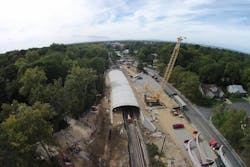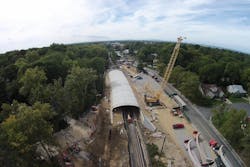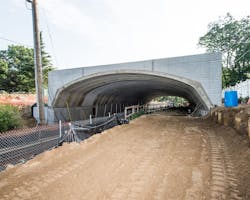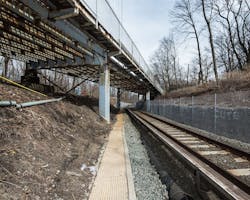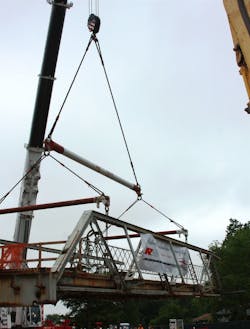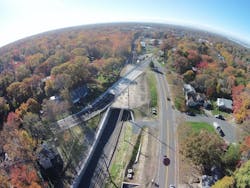A better bridge
In 2014, the Long Island Rail Road (LIRR) initiated the full replacement of a 115-year-old bridge in the village of Thomaston, N.Y. Thomaston, located in Nassau County, Long Island, is a mere 0.4 sq miles. The town is separated in two by a single-line railroad track which opened in 1898, and has since acted to benefit commuters to and from Manhattan and the surrounding area
Thomaston is highly residential, with a population of just 2,727 at the time of the Colonial Road Improvement Project’s completion. In a small town such as this, dysfunctional infrastructure does not go unnoticed.
At over a century old in 2014, the Colonial Road Bridge was due for either replacement or rehabilitation. Though its age was impressive, the standard design of the road bridge yielded the structure unworthy of historic or architectural preservation; thus, LIRR decided to fully replace the bridge under a design-build contract totaling over $24 million.
After the removal of the original bridge, crews were to install 84 precast arches made by Contech Engineered Solutions.
The work
Railroad Construction Company Inc. (RCC) of Paterson, N.J., and their designer KSE/WSP, a joint venture, were contracted by LIRR to construct and install a replacement bridge in the village of Thomaston. The new bridge would keep the existing Colonial Road alignment, and would improve the existing right-of way to mitigate flooding and drainage issues.
To kill two birds with one stone, LIRR proposed the construction of a new 12-car pocket track east of Colonial Road on top of the bridge replacement work. This addition now allows the railroad to turn trains faster for better rush-hour service. LIRR operates about 735 trains on the average weekday across its 120 miles of track. As the busiest commuter railroad on the continent, LIRR serves 265,000 customers each day; with this in mind, better service is a necessity to maintain customer satisfaction.
The new pocket track acts as a stop-off for trains that are not in use beyond rush-hour or special-event traffic. When the trains are needed, they provide additional seating availability to commuters who would otherwise be cramped on the same train, or forced to find a different form of transportation.
With the work awarded, the project began in early 2015. Early construction required grading, moving earth along the LIRR right-of-way (ROW) and the installation of retaining walls in some locations to support the new bridge structure. The establishment of fenced staging areas for contractor field offices, equipment and supplies were also completed in the early stages. These areas also accommodated to stockpile materials.
Later, RCC installed sheeting adjacent to the right-of-way. Utilities in close proximity to the work were relocated in order to accommodate to the imminent 52-hour track outage for the replacement of the existing bridge. Colonial Road was closed for one year, from March 2015 to March 2016, in order to accommodate the construction of the new bridge.
After the removal of the original bridge, crews were to install 84 precast arches made by Contech Engineered Solutions. The arches were 11.5 in. at their thickest points, and 10.75 in. at their thinnest. The precision that these arches demanded was an impressive feat by Contech to say the least. Combined, the 84 arches spanned 52 ft in length and weighed 21 tons. They were installed over two weekend-long track outages.
GCCOM Construction Company was subcontracted by RCC to furnish and install the arches. Incredibly, GCCOM was able to set and secure about three arches per hour. Their efficiency allowed the rest of the team to perform to the best of their abilities.
The final stage of the project revolved around the actual replacement of the bridge, as well as signal modifications, switches, crossovers and other track-related aspects of work. As common with all projects of this magnitude, the Colonial Road Bridge Improvement Project saw various challenges along the way.
In theory, constructing 84 precast archways might not sound like much of a feat for a professional firm, but the precision of each individual arch demanded some highly intensive engineering.
The challenges
As with any construction projects, finding adequate space to place materials, park equipment and even to congregate is always a primary concern. RCC made due with a small lay-down area near the work site, but soon encountered other challenges.
The project called for drainage improvements to the site, all of which ran parallel to the railroad track. Safety protocol typically calls for flagmen in this scenario, but RCC made the executive decision to install fencing along the ROW in order to better manage performance time. While the fencing created a safe work space for crews, the area was extremely tight, and made the use of heavy construction equipment all the more challenging.
Further, the runoff that crews encountered was nothing like what they had expected. Once sheeting was driven alongside the rail, drainage became a major concern. The soil that crews encountered was heavily concentrated with clay, which made for wet conditions. The drainage system that was in place required containment to keep it from shifting, so RCC instilled a makeshift wooden confinement along the line to keep it in place. With drainage under control and crews accustomed to their work environment, they were able to continue working toward the grit of the project: the new bridge.
In theory, constructing 84 precast archways might not sound like much of a feat for a professional firm, but the precision of each individual arch demanded some highly intensive engineering. Dan Logel, Contech’s New York bridge consultant, recalled the feat: “Fitting these arches in the tight geometry available—and matching the radius—was certainly one of [Contech’s] more-complex and challenging projects. These were very thin arches, so we had to be very precise,” he said. The arches were placed together over the railroad tracks in alignment with the original bridge.
“Bridge footings were also a challenge,” said Logel, “due primarily to difficult soils, tight right-of-ways, and nearby buildings and developed property. Initial design called for cast-in-place drilled caissons and lagging, but there were problems.” These problems proved to be one of the defining factors of the project’s operation.
At over a century old in 2014, the Colonial Road Bridge was due for either replacement or rehabilitation.
RCC Project Manager Adam Schmit also commented on the challenge: “Caisson construction operations would have required high mast equipment. That would expose construction to overhead utility delay and increase track safety concerns.”
In a thoughtful engineering effort, crews determined that making small layout modifications rather than drilled caissons would allow them to design spread footing foundations. With this change in mind, RCC was able to utilize standard and hi-rail construction equipment to avoid overhead wire issues.
What proved to be more difficult than constructing and setting the archways was delivering them. Contech’s Kingston facility was the origin of the arches, over 100 miles away from Thomaston. This meant that each arch had to be placed on a flatbed truck and driven across a major bridge to reach Long Island. In the words of Dan Logel: “That’s not easy.”
Contech hired 42 flatbed trailers to accommodate the 1,764-ton load. Each bed was about 12.5 ft wide by 60 ft long, accommodating the 52-ft archways. Loads of this size do not fare easily over the Hudson River, so coordinating with NYPD for a safe and painless escort was a necessity. “We ended up crossing in the dead of night when traffic was lighter,” said Logel. “Timing was everything.”
Once they had arrived, the flatbeds needed somewhere to sit while they waited to unload. In a 0.4 sq mile town, space is limited. Of the 42 trailers, 19 were able to fit in the lay-down area near the construction site. Another 16 were set at a nearby site that crews were able to reserve. The remaining nine flatbeds had to park on the road, but crews did everything they could to minimize the impact to the local community.
Beyond the specifics of the project, various challenges existed that are more common with track-related construction. For example, much of this project’s work was performed at night or on weekends to accommodate to commuters. Furthermore, noise, vibration and the overall presence of construction had to be kept to an absolute minimum as to not disturb local residents. The lengthy combination of experience between team members made meeting these expectations rather easy, and in the end the final product was rather rewarding.
Colonial Road was closed for one year, from March 2015 to March 2016, in order to accommodate the construction of the new bridge.
The new bridge
After they had been set in place by GCCOM, the 84 archways created a tunnel through which LIRR trains can run without impact to local traffic in the quiet town of Thomaston. The new road bridge was constructed thereafter, and the new piece of infrastructure is an improvement to the safety and appearance of the existing ROW. The new tunnel even reduces noise levels for nearby residents as compared to the original 20th century bridge structure.
RCC, KSE, GCCOM and Contech’s efforts made the project one of the most well-performed of the year. Timeliness, teamwork and tenacity were key aspects in the project’s completion, and the team’s efforts did not go unrecognized. In March of 2017, not long after the opening of the new bridge, the Colonial Road Improvement Project was selected by the American Society of Civil Engineers (ASCE) Metropolitan Section as the recipient of the “Metropolitan Section Design/Build Project of the Year.”
Originally, residents of Thomaston were against the replacement of the bridge, telling News 12 Long Island that “they don't want to feel as though they live alongside a noisy subway, and are worried the plan will bring congestion to their neighborhood.” Public hearings were held, and eventually, LIRR went forward with the project. Today, residents are more than pleased with the final structure.
The new bridge and track improvements cut the travel time of commuters who work on Manhattan’s east side by 20 to 30 minutes because of the new width of the bridge. The wider bridge allows trains to make faster turns and, not to mention, is a wonderful addition to the aesthetics of the town as compared to the original bridge.
“There haven’t been any issues with the new bridge,” said Schmit. “Everything went according to plan. It worked out perfectly.”
As of November 2018, the new Colonial Bridge is performing as anticipated. A better bridge led to quicker trains, which led to timelier commutes, which made for happier LIRR customers. As final touches are completed, the hard work that went into the bulk of the project is looked back on in a positive light. The construction team and project owner could not be more pleased with the final outcome of the Colonial Road Improvement Project.
The new bridge and track improvements cut the travel time of commuters who work on Manhattan’s east side by 20 to 30 minutes because of the new width of the bridge.
